It's almost shocking that head-up displays in motorcycle helmets aren't common by now. After all, the technology to project vital data up into the pilot or driver's field of view has existed for decades in both the aviation and automotive industries. Applying the technology to motorcycling could prove to be even more beneficial, by keeping a rider's eyes up and focused on the road. BMW has offered optional HUD systems in its cars since 2003 and is now keen to apply the technology to motorcycling and showed its first concept at the Consumer Electronics Show in Las Vegas.
But BMW isn't the only company in this space. There has been a flurry of activity in this area in recent years, with multiple start-up companies racing to be the first to market with a functional, affordable application of HUD technology in a motorcycle helmet. Leading the charge is Skully Systems and its AR-1 helmet (currently doing demos around the U.S., with deliveries of consumer units expected by summer 2016). With Skully's design, it has had to create both a helmet (meeting existing DOT regulations) and all the technology to go in that helmet safely. While another start-up, Nuviz is, concentrating its efforts on an accessory that attaches to the outside of an existing full-face helmet of the rider's choice.
And although a major existing helmet company has yet to commit to bringing a similar lid to market, Bell Helmets recently announced its collaboration with 360fly that’s yielded new helmets with integrated video cameras: the Moto 9 Flex off-road and Star full-face street lids.
Currently, BMW Motorrad is hard at work developing its own interpretation of a head-up display helmet with “mini-computer” and integrated speakers. In the case of BMW, its biggest interest in the technology is to provide the rider with pertinent information that would otherwise require a glance away from the road. The BMW helmet will be paired to the motorcycle so that information such as tire pressures, oil level, fuel level, speed, gear position, and speed limit can be displayed inside the rider’s faceshield as conditions require. Future potential would include navigation, rear-view and forward-facing cameras, traffic updates, and warnings of danger: “By means of the future V2V (vehicle-to-vehicle) communication, it might also be possible to display information in real time, for example to give due warning of any suddenly impending hazards.” BMW hopes to bring the helmet to market in the next couple of years.
In the meantime, it appears Skully will have a good head start (even it if doesn’t have the same manufacturing or tech scope as BMW), with the first generation of the AR-1 offering a 180-degree rearview camera, Bluetooth connectivity to a smartphone allowing voice-activated navigation, music streaming, and speed display. Features will be added, no doubt, as more motorcycles allow electronic devices to be tethered to them.
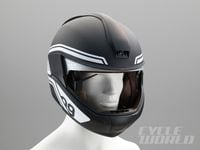




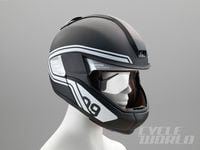
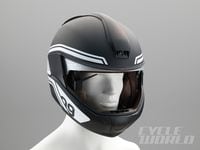
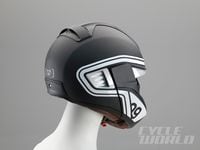
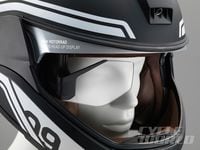
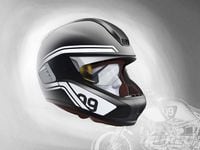
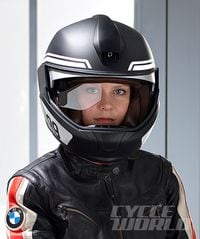
/cloudfront-us-east-1.images.arcpublishing.com/octane/6KWAL3TFNJBGTJMJSKQ2C6I3IY.jpg)
/cloudfront-us-east-1.images.arcpublishing.com/octane/GK5I5R3X7JCABGCKAKT4XY2K7U.jpg)


/cloudfront-us-east-1.images.arcpublishing.com/octane/RGUT3Y65IFGDFMLHQ3U7G5UUQE.jpg)

/cloudfront-us-east-1.images.arcpublishing.com/octane/37CSHD6CKRHYXHRB67EOLDS6XM.jpg)
/cloudfront-us-east-1.images.arcpublishing.com/octane/FYB7GKDGLVE3JKXMM75JTG2RYA.jpg)
/cloudfront-us-east-1.images.arcpublishing.com/octane/3ECVMM622VAZHIOLI6Q6ILWULU.jpg)


/cloudfront-us-east-1.images.arcpublishing.com/octane/UIZQ7VXRCRHBVDFK5RFJIEBBAU.jpg)

/cloudfront-us-east-1.images.arcpublishing.com/octane/QXBJ4CVEEBG2BF5O3TOPIGP7ZE.jpg)


/cloudfront-us-east-1.images.arcpublishing.com/octane/HGNDJUKK4FHNTP5XEYYHWVW6NI.jpg)
/cloudfront-us-east-1.images.arcpublishing.com/octane/GDGQOIQBDBCXLIUZUEMCP2C5ZE.jpg)
/cloudfront-us-east-1.images.arcpublishing.com/octane/M6Z3IHJEAZE4XDQGCFN7YPJEOA.jpg)
/cloudfront-us-east-1.images.arcpublishing.com/octane/L6GYTNOQB5FOXPUZIQZYQSJ3PI.jpg)
/cloudfront-us-east-1.images.arcpublishing.com/octane/FCGZHQXRBZFLBAPC5SDIQLVF4I.jpg)
/cloudfront-us-east-1.images.arcpublishing.com/octane/CWPFD2XJ6VHSJK3YMIJGHRJ5SA.jpg)
/cloudfront-us-east-1.images.arcpublishing.com/octane/4TTNZVVO6ZGN7AQUHVGHM4NFLQ.jpg)
/cloudfront-us-east-1.images.arcpublishing.com/octane/RXDCXNV46VFEVM4FNKCBPCTQXE.jpg)